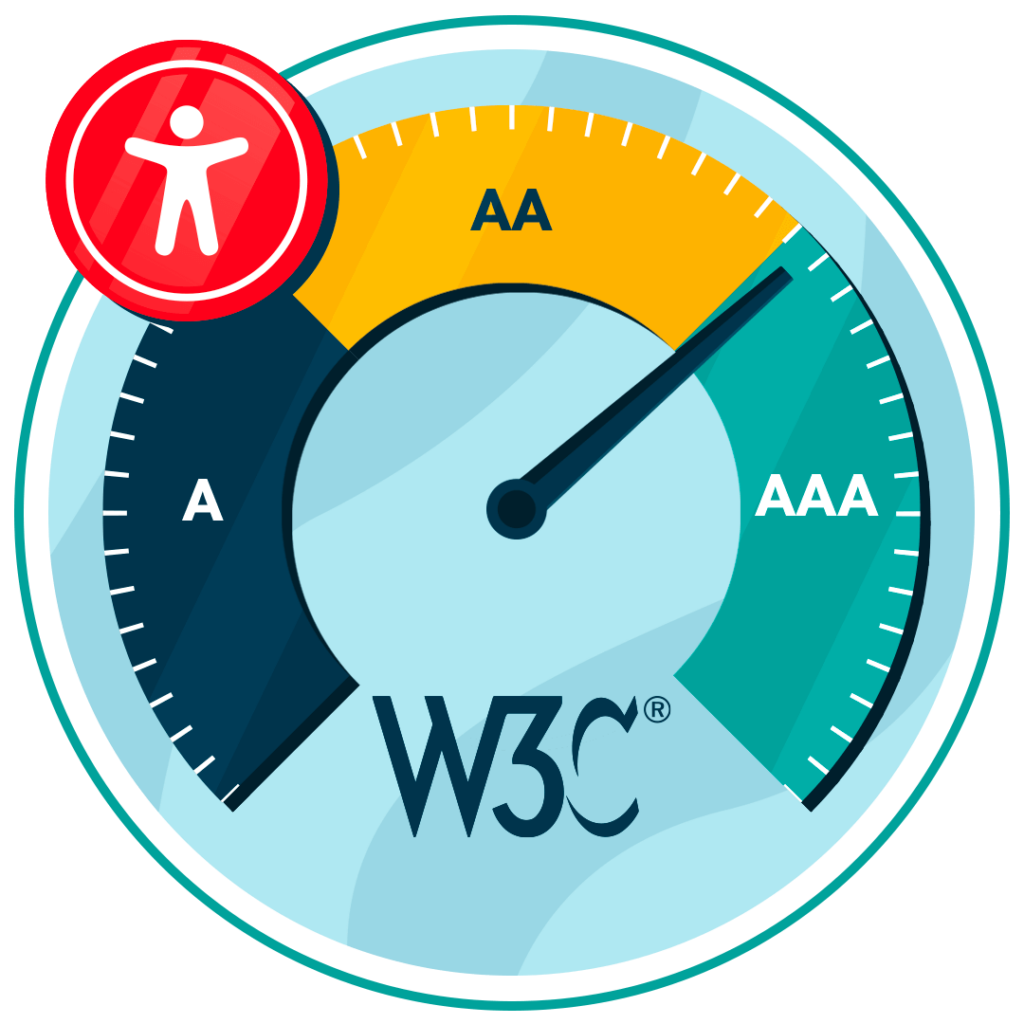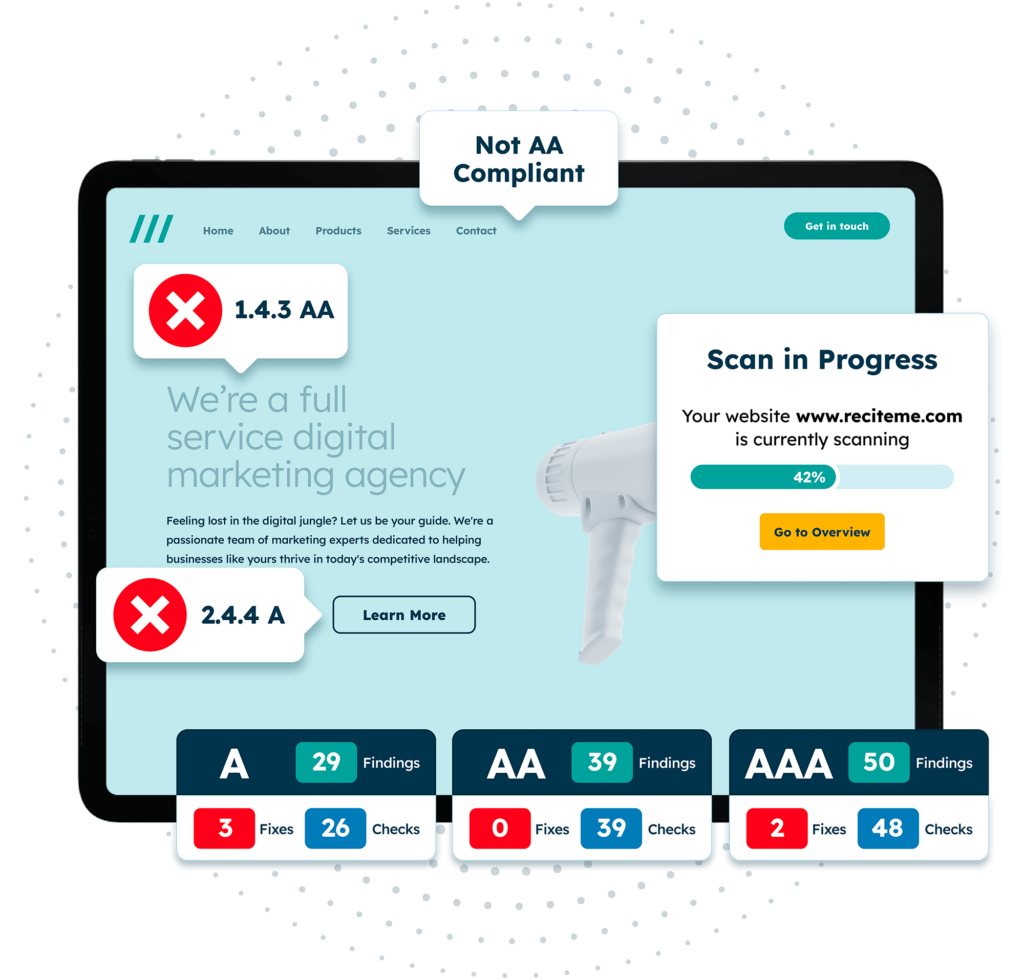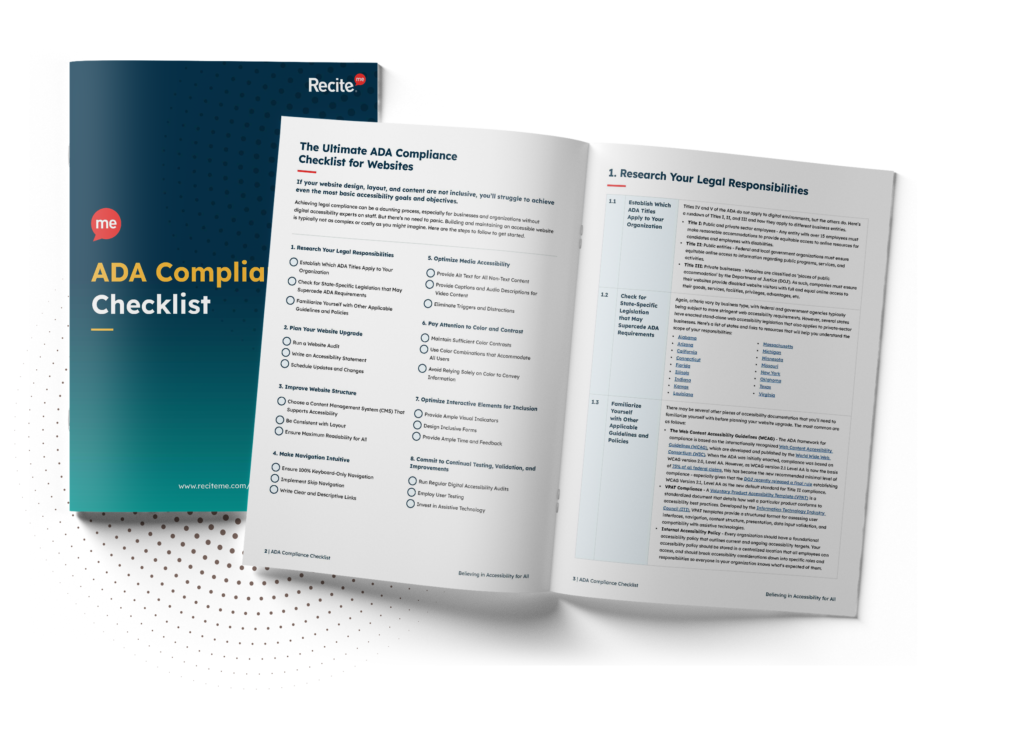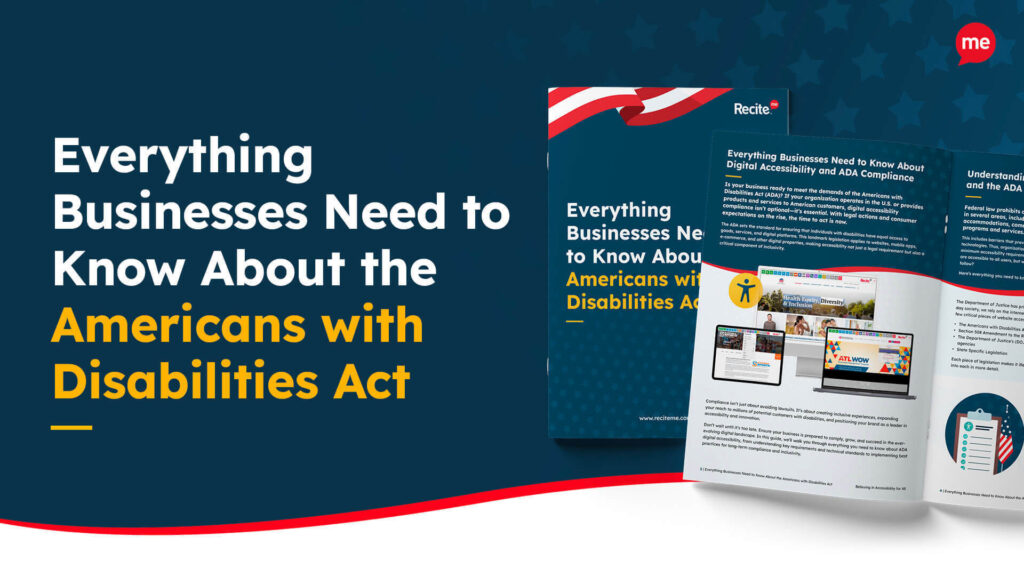Download Our Free ADA Compliance Checklist
Download NowThe Americans with Disabilities Act (ADA) has shaped accessibility practice dramatically in the US. But how does it affect SEO? In this article, we’ll explore how accessibility compliance can impact your search engine performance.
The basics of ADA compliance for websites
The ADA is a piece of legislation that aims to protect disabled Americans from discrimination. Under this law, organizations are required to identify and address accessibility barriers. For example, these could be barriers that prevent the disabled from accessing and engaging with their services, products, and/or facilities.
Titles II and III of the ADA are especially relevant to website compliance.

Key accessibility standards for compliance
Web Content Accessibility Guidelines (WCAG) are used as a framework for ADA compliance. These globally recognized standards set out how to create a web content that is accessible for all audiences. WCAG version 2.1 Level AA is the most commonly referenced in ADA legal cases, and is widely considered the benchmark for ADA compliance.
You should also aim to familiarize yourself with the four key principles that underlie WCAG. These are “POUR”:

- Perceivable: You must ensure visitors can perceive your content regardless of their abilities, e.g., by adding captions to videos for deaf and hearing impaired visitors.
- Operable: Web users must be able to use your website regardless of whether they use a mouse, keyboard-only, screen reader, or another assistive device.
- Understandable: The design and content of your website should be clear and understandable to users, e.g., with a hierarchical structure, easy-to-read fonts, and jargon-free language.
- Robust: Your website and its content should continue to be accessible regardless of technological advances and updates, e.g., it should work with new assistive technologies as they release.
Get a free automated ADA compliance audit of your website. This audit will highlight compliance violations and provide the recommendations needed to meet ADA compliance standards.

The basics of SEO and why it’s essential for business growth
Search Engine Optimization (SEO) involves optimizing your website so that your content ranks higher in search engine results. It has both on-page and technical elements that need to be addressed, including:
- Creating informative, keyword-rich content
- Building backlinks with trusted websites
- Improving technical SEO, such as website speed, adding meta-data, resolving redirects
SEO is essential for your business growth as it specifically targets people who are searching for your products/services or industry-relevant content. It makes your business visible, and drives these high-intent users to your site.
That can help you to increase your customer base and develop a strong reputation online. Plus, SEO is organic marketing, so aside from paying for a backlink or keyword tools occasionally, there are few costs involved. That’s especially true compared to paid advertising.

How ADA Compliance can boost your SEO performance
Adjusting your website for ADA compliance can also impact your SEO performance. Here’s how:

Better crawlability for search engine bots
Semantic HTML and ARIA is used to improve the accessibility of web content for disabled people. For example, Semantic HTML provides additional meaning to HTML elements than traditional HTML does. ARIA (Accessible Rich Internet Applications) serves a similar purpose, but works like a set of attributes, and needs to be used sparingly due to the risk of errors.
By adding important context to your web content, assistive technology can read the structure of your webpages more easily. That improves the user experience of those who utilize screen readers, for example. As a bonus, webpages with proper semantics are also essential for SEO, as they allow search engines to rank your content correctly, improving online visibility.
Improves the structure of your content
Implementing the correct heading hierarchy on your website improves accessibility and SEO. As with semantic HTML, it provides a clear structure for the webpage, allowing both screen readers and search engines to understand the content.
Faster loading times for web pages
Slow loading times can be highly frustrating for disabled web users, making it difficult to navigate with screen readers.
It’s also a major SEO issue, particularly for mobile web users. According to data from Google, slower page load times can increase the number of mobile users clicking away from your website by up to 123%!
Improved user experience
Accessible website navigation, such as through proper semantics and keyboard-only navigation, means lower bounce rates. This refers to the rate of users clicking a link to your website, then immediately clicking away without browsing other pages on your site. It’s usually a sign something isn’t right with your webpage or broader website.
By improving user experience for disabled people, they’re more likely to stick around and reduce bounce rates.

Multimedia optimisations
Image and video content accessibility also improves SEO. For example, image content can be made “visible” for blind and visually impaired people through alt-text. These refer to short, detailed text descriptions that you can add to website images. Screen readers can then read out the alt-text, making the content accessible for all.
Alt-text is also useful for search engine crawlers. It helps search engines to understand the image and its relation to the webpage. By adding relevant SEO keywords within the alt-text, you can flag up to search engines that the webpage content relates to these terms. This can contribute towards increased organic search ranking. Captions and transcripts can offer similar SEO benefits for your accessible video content too.
The SEO benefits of specific ADA accessibility features
Aside from these broader benefits, there are specific examples of how ADA compliance can give your SEO a boost. We’ve compiled some of these in the table below.
| Accessibility Feature | SEO Benefit |
| Alt text for images | Improves image search rankings |
| Descriptive link text | Enhances keyword relevance |
| Proper heading structure | Boosts content readability and indexing |
| Transcripts for audio | Makes audio content searchable |
| Captions for videos | Improves video SEO |
| Semantic HTML | Aids search engine parsing |
| ARIA labels and roles | Improves content clarity |
| Keyboard navigation support | Reduces bounce rates |
| Mobile-friendly design | Improves rankings in mobile search |
| Clear form labels and errors | Improves conversions |
| Skip navigation links | Improves usability |
| Well-structured metadata | Increases SERP relevance |
Legal and business risks of ignoring ADA compliance
When you ignore ADA violations, you’re not just risking your search engine rankings. From significant fines to poor reputation, there are many risks to consider.
Lawsuits and legal fees of non-compliance
The most immediate risk to your business is legal action. It’s likely more common than you think, with over 4,000 ADA compliance lawsuits filed in 2024. That’s up from 814 lawsuits recorded back in 2017.
Naturally, these can be very costly for your business. For example, consider the $6-million settlement Target paid to the National Federation of the Blind following Title III violations on their website.
Don’t forget about ADA fines either. For Title III, these can range between $55,000 to $75,000 for first violations. If you commit further violations, you could be liable for up to $150,000. That’s not something your business can afford to ignore.


Damage to brand reputation
Around 1 in 4 Americans are recorded as disabled. Refusing to provide reasonable accommodations for this group is highly unethical. It prevents disabled people from living their lives to an equal standard as those who are able bodied.
Inaccessible websites will lead to a poor reputation for your business. From criticism on social media to boycotts, unethical business practices can have dire consequences. In fact, over half of Americans surveyed by YouGov reported boycotting unethical brands.
Loss of potential customers with disabilities
Ignoring disabled customers isn’t just a moral issue, it’s bad for business too. After all, estimates place this group as having a collective spending power of $8 trillion annually. If their friends and family are also included, that statistic rises to a whopping $13 trillion!
If your product images, blog content, and web forms are inaccessible to this group, you’ll be missing out on this lucrative market.

Practical steps for achieving ADA compliance and SEO gains
It’s essential to put practical steps in place to improve your ADA compliance. In turn, that can have a positive impact on your SEO.
Audit your website for accessibility issues
First, you need to identify the accessibility issues on your website. This might sound like a mammoth task, but it really doesn’t have to be. Start by using our automated accessibility checker to conduct a free accessibility audit.
This tool will provide you with a full report of ADA compliance issues, including the resolutions to put in place. It’s based on WCAG 2.1 Level AA criteria, making it simple to meet ADA guidelines.
Whilst automated tools are highly efficient, it’s always best to let a human double check for violations. Once you’ve completed the automatic audit, follow-up manually with our free ADA accessibility checklist.
Use your audit to remediate ADA violations
Once you’ve conducted an audit, the next step is to review the report and remediate violations. Prioritizing accessibility remediations is essential, as some will be more significant than others.
For example, you should aim to focus on:
- Fast fixes: These are violations that can be resolved quickly. Keep in mind that an accessibility checker also features some easy AI-driven fixes to save you time, including for alt-text.
- Major violations: These are the big issues that prevent disabled users from accessing, navigating, or engaging with your web content, such as inaccessible menus and forms.
- High-traffic web pages: These violations occur on important web pages with high customer traffic, like product/service pages and homepages.
When these issues are resolved, you can move onto more labor-intensive adjustments.

Monitor and maintain compliance continuously
ADA compliance isn’t a one-off event. Whether you add new content to your website or new disability legislation is released, web accessibility can change fast. You need to continuously monitor your digital content for violations, and make adjustments where necessary.
That should include regularly scheduled automated and manual audits. Prioritize audits after a big change in legislation, assistive technology, or company content. Make sure to ensure your team is well-versed in online inclusivity through web accessibility training. This makes it easier for them to create ADA-compliant content for years to come.
Want to make sure your website is compliant with the Americans with Disabilities Act? Then unlock the ADA compliance checklist now. Discover actionable steps to ensure ADA compliance, helping you avoid lawsuits and any other negative consequences of non-compliance.

Make sure your website is ADA compliant and SEO optimized
ADA compliance and SEO are two of the biggest factors for a successful website. Neglecting ADA accessibility is an issue in itself, but as we’ve explored, it also has an effect on SEO.
If you want a website that draws customers and provides accessibility, then a free website audit is a good place to start. Our web accessibility checker provides all the tools you need to identify ADA violations and resolve them.
ADA Compliance and SEO FAQs
Looking for a recap or quick summary? Here are a few of our most frequently asked questions to help you get to grips with the essentials:
Does ADA compliance affect SEO?
Yes, absolutely. ADA compliance can boost your SEO through:
- Descriptive alt-text for images
- Semantically correct heading hierarchies
- Improved loading times
- Accessible web navigation, including keyboard-only navigation
- Video captions
Does accessibility score affect SEO?
No, accessibility does not directly affect SEO rankings. However, making adjustments to your webpages to improve accessibility can have an impact on SEO.
For example, “alt-text” textual descriptions can be added to your website images. These can be read by screen readers for accessibility and search engines for improved SEO.
What accessibility factors will affect your SEO strategy?
There are several accessibility factors that you should consider when planning your SEO strategy, including:
- Providing semantically correct webpage structure to make content clear for assistive tech and search engines.
- Improving website performance, including page loading and responsive designs.
- Good user experience, including accessible navigation, to reduce bounce rates.
Need more help becoming ADA compliant?
The following resources are packed full of actionable tips and expert advice for making your digital content compliant with the Americans with Disabilities Act:
Free ADA Accessibility Training
Take the first step to ADA compliance by completing our training course.
Free ADA Accessibility Guide
Ensure your organization is meeting the requirements for ADA compliance.






